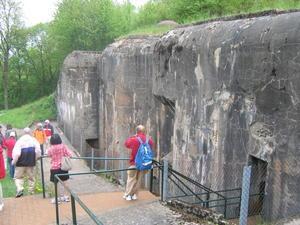Advertisement

 1
1
One of the entrances to the Maginot Line structure. In addition to 4' thick walls, it was surrounded by barbed wire.Hello everyone,
We had the most interesting visit to the Maginot Line. We were told that the French started building it in 1929 in a spirit of "never again" after they were so badly hit during WWI. The purpose was to protect that part of their border that wasn't protected by friendlies--Belgium or by natural defence--mountains. Also, military service had been reduced to one year, so this conserved manpower. It was five hundred miles of subterranean tunnel that contained a rail system for moving ammunition. The walls were constructed of brick, cement and gridiron and were almost four feet deep. During WWII it accommodated 1,000 men and forty officers. They worked in three shifts, eight hours of defence work, eight hours of sleep, six hours of repair and maintenance work with the final two hours to be spent outside to get sunshine and fresh air. They were completely self-contained--even a hospital and dentist. The food was boring--beans, rice, beef and two pounds of bread per day. Being French, wine was part of the diet plus a morning ration of rum. Ammunition was stored with a sort of moat in front of the storage area so if there was a fire

 2
2
Ammunition--50,000 shells--stored in special area that had a moat in front to protect area from spreading fire.the 50,000 shells would be protected. The structure created a false sense of security for France. It was no match for German forces, but was taken back by U.S. forces under Patton in November 1944.
The same day we visited Metz, one of the cities protected by the Maginot Line. Our guide told us that more U.S. G.I.s were killed in liberating Metz than at Normandy. Metz goes back 3,000 years, but the towers from the 14th century were the most interesting. There were 62 in all--a German initiative. Each trade was ordered to erect a tower and outfit it for 100 soldiers with a six month suply of food. We saw the wine maker tower.
The guide was a real treat--he is from Montreal. He was stationed in France 51 years ago with NATO. That is where he met his wife. He was stationed at Trenton in the late 60's. Retired after 39 years and settled in Metz because he always loved Medieval architecture.
Bye for now,
Donna
Advertisement
Tot: 0.255s; Tpl: 0.01s; cc: 14; qc: 72; dbt: 0.0661s; 1; m:domysql w:travelblog (10.17.0.13); sld: 1;
; mem: 1.2mb

 1
1
 2
2







Marg Hambly
non-member comment
Tunnels and walls...
Seeing structures like these sure makes us glad we grew up in a place and a time when we did, doesn't it? I can't even imagine an 8 ton door, let alone being confined behind it for a long period of time. You are certianly getting a look into the past first hand! Good to hear from you... Marg